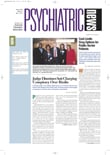Children with generalized anxiety, separation anxiety, or social phobia disorder may benefit from taking fluvoxamine (Luvox).
A new study shows that children who were given the drug over eight weeks significantly improved compared with children given placebo.
The results of the first controlled trial of an SSRI in children with anxiety disorders was published in the April 26 New England Journal of Medicine.
Approximately 1 in 8 children suffers from an anxiety disorder, yet the vast majority are not diagnosed and treated, according to the Anxiety Disorders Association of America (ADAA). The ADAA blames this in part on a lack of rigorous research on the prevention and treatment of childhood anxiety disorders.
The authors found that a daily dose of up to 300 mg of fluvoxamine in adolescents and 250 mg in children under age 12 significantly decreased their anxiety symptoms by eight weeks compared with placebo.
A total of 128 children ages 6 to 17 years participated in the study, which was conducted at six sites: the National Institute of Mental Health (NIMH), Johns Hopkins University, Duke University, Columbia University and New York State Psychiatric Institute, University of California at Los Angeles, and Nathan Kline Institute in New York. NIMH and Solvay Pharmaceuticals, the maker of fluvoxamine, funded the multicenter study.
The authors explained in the article that they decided to focus on separation anxiety, social phobia, and generalized anxiety disorders because they commonly occur together.
The authors studied fluvoxamine because it was the only SSRI approved for use in children in 1996 when the study was designed. The drug was approved by the FDA for the treatment of obsessive-compulsive disorder (OCD) and appears to be effective, the authors noted in the article.
Psychiatrist and co-investigator John March, M.D., at Duke University, told Psychiatric News that physicians are widely prescribing SSRIs for children with anxiety disorders although only fluvoxamine has been approved by the FDA for use in this age group.
IMS Health, which tracks the pharmaceutical industry, reports that of the 575,000 children nationwide diagnosed with anxiety disorders in the 12 months ending in March, 390,000 were prescribed SSRIs such as fluoxetine (Prozac), paroxetine (Paxil), and sertraline (Zoloft). Of these, 89,000 were under the age of 10. The data come from national surveys that IMS Health conducts each month of physicians’ diagnosing and prescribing practices.
March and other psychiatrists are cautious about prescribing an SSRI in children without having tried cognitive-behavioral therapy (CBT) first or in combination with an SSRI, depending on severity and comorbidity.
“This would parallel expert recommendations for OCD and attention-deficit/hyperactivity disorder [ADHD],” said March.
The authors mentioned that studies of CBT in children with anxiety disorders show that CBT’s response rates are similar to those of fluvoxamine, ranging from 70 percent to 80 percent.
“We are hoping to secure NIMH funding for a multisite study that will compare the effectiveness of CBT with an SSRI in children with anxiety disorders,” said March.
Studies involving children must undergo a rigorous informed-consent and institutional review board approval process.
The authors cited three limitations of their fluvoxamine study—the children were on the drug for only eight weeks, children with comorbid disorders such as depression and ADHD were excluded, and the study design did not require the clinical outcomes and adverse events data to be evaluated independently.
An abstract of “Fluvoxamine for the Treatment of Anxiety Disorders in Children and Adolescents” is posted on the Web at www.nejm.org/content/2001/0344/0017/1279.asp. ▪
